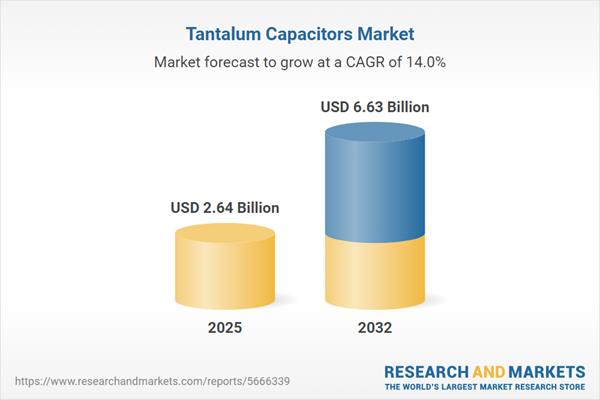Speak directly to the analyst to clarify any post sales queries you may have.
The tantalum capacitors market is experiencing marked transformation, with strong demand from electronics, automotive, and industrial sectors driving rapid advancements in materials and manufacturing. Senior decision-makers seeking to safeguard supply, manage risk, and leverage evolving capabilities will find strategic value in this comprehensive report.
Market Snapshot: Tantalum Capacitors Market Growth and Opportunity
The Tantalum Capacitors Market grew from USD 2.32 billion in 2024 to USD 2.64 billion in 2025. It is expected to continue growing at a CAGR of 13.99%, reaching USD 6.63 billion by 2032. Market expansion is underpinned by escalating innovation in electronic miniaturization and critical-application reliability. Technological upgrades, integration into emerging networks, and supply chain evolution position tantalum capacitors as pivotal within the global components landscape.
Scope & Segmentation: Comprehensive Coverage of the Tantalum Capacitors Landscape
This report delivers an in-depth analysis of the tantalum capacitor market, spanning diverse segments, geographies, and technologies relevant for informed strategic planning.
- Type: Solid Tantalum, Wet Tantalum
- Mounting Type: Surface Mount, Through Hole
- Application: Audio Circuits, Coupling & Decoupling, Power Supply Filtering (including Dc-Dc Converters and Voltage Regulators), Timing
- Voltage Rating: High (>50V), Low (<10V), Medium (10-50V)
- Packaging: Bulk, Tape & Reel, Tray
- Regions: Americas (United States, Canada, Mexico, Brazil, Argentina, Chile, Colombia, Peru), Europe, Middle East & Africa (including United Kingdom, Germany, France, Russia, Italy, Spain, Netherlands, Sweden, Poland, Switzerland, United Arab Emirates, Saudi Arabia, Qatar, Turkey, Israel, South Africa, Nigeria, Egypt, Kenya), Asia-Pacific (China, India, Japan, Australia, South Korea, Indonesia, Thailand, Malaysia, Singapore, Taiwan)
- Key Companies: Yageo Corporation, KYOCERA AVX Corporation, Vishay Intertechnology, Inc., TDK Corporation, Panasonic Corporation, Murata Manufacturing Co., Ltd., Samsung Electro-Mechanics Co., Ltd., Taiyo Yuden Co., Ltd., NEC TOKIN Corporation, ELNA Co., Ltd.
Tantalum Capacitors Market: Key Takeaways for Strategic Planning
- Material innovation continues to elevate performance, with advanced dielectric formulations meeting the requirements of both miniaturized consumer devices and high-reliability industrial applications.
- Environmental initiatives and the integration of recycled tantalum are influencing product strategies, reducing environmental impact, and contributing to lifecycle sustainability goals for leading OEMs.
- Manufacturers benefit from automation-friendly surface mount options while maintaining through hole choices for power and legacy systems, balancing efficiency and mechanical stability.
- Smart segmentation by application and voltage rating enables targeted development for sectors like automotive electrification and expanding 5G infrastructure, aligning R&D with strongest market pull.
- Intensified regional competition, particularly in Asia-Pacific, is fostering ongoing advancements in volumetric efficiency, supply chain resilience, and high-frequency performance suitable for next-generation network rollouts.
Tariff Impact and Global Supply Chain Strategies
Recent United States tariffs have driven significant shifts in sourcing and procurement, compelling global manufacturers to reassess supplier networks and logistics. Dual-sourcing, secondary processing near end-markets, and increased investment in scenario-based risk management tools are now central to mitigating volatility. Collaboration among distributors, manufacturers, and policy stakeholders is vital for continuity and agility in meeting ongoing market demands for tantalum capacitors.
Methodology & Data Sources
The report uses a hybrid approach, drawing from secondary research such as technical journals and patent analysis, validated by interviews with senior executives, raw material suppliers, and association representatives. Quantitative and qualitative insights are cross-validated through a rigorous peer review process, ensuring findings are credible, actionable, and directly relevant to senior decision-makers considering investment or procurement within the tantalum capacitors market.
Why This Report Matters for Decision-Makers
- Gain actionable insights on optimizing global supply chains, technology investments, and procurement models under shifting regulatory landscapes.
- Understand evolving segment dynamics and regional differences to align product development and market entry with high-growth opportunities.
- Leverage strategic recommendations to enhance resilience, foster innovation, and strengthen competitive positioning in critical application sectors.
Conclusion
This report equips senior leaders with clear perspectives on market evolution, risks, and strategic imperatives for tantalum capacitors. Grounded in objective analysis, it supports well-informed decisions for sustained advantage across dynamic electronic component markets.
Additional Product Information:
- Purchase of this report includes 1 year online access with quarterly updates.
- This report can be updated on request. Please contact our Customer Experience team using the Ask a Question widget on our website.
Table of Contents
3. Executive Summary
4. Market Overview
7. Cumulative Impact of Artificial Intelligence 2025
Companies Mentioned
The companies profiled in this Tantalum Capacitors market report include:- Yageo Corporation
- KYOCERA AVX Corporation
- Vishay Intertechnology, Inc.
- TDK Corporation
- Panasonic Corporation
- Murata Manufacturing Co., Ltd.
- Samsung Electro-Mechanics Co., Ltd.
- Taiyo Yuden Co., Ltd.
- NEC TOKIN Corporation
- ELNA Co., Ltd.
Table Information
| Report Attribute | Details |
|---|---|
| No. of Pages | 183 |
| Published | October 2025 |
| Forecast Period | 2025 - 2032 |
| Estimated Market Value ( USD | $ 2.64 Billion |
| Forecasted Market Value ( USD | $ 6.63 Billion |
| Compound Annual Growth Rate | 13.9% |
| Regions Covered | Global |
| No. of Companies Mentioned | 11 |









